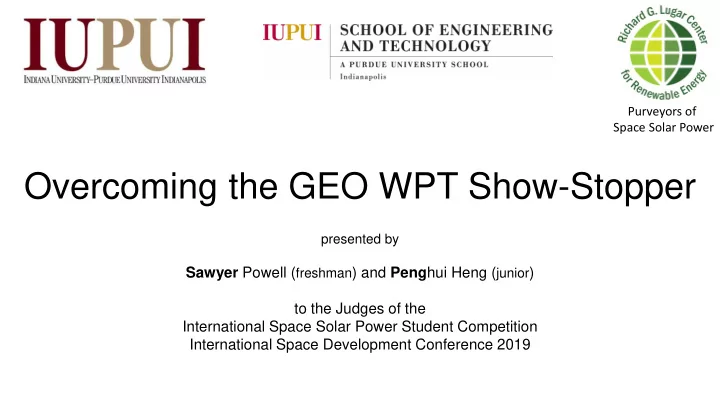

Purveyors of Space Solar Power Overcoming the GEO WPT Show-Stopper presented by Sawyer Powell ( freshman ) and Peng hui Heng ( junior ) to the Judges of the International Space Solar Power Student Competition International Space Development Conference 2019
Introduction Areas of Focus: 1. Layout & Spacing of Spacetenna Design 2. Error Detection and Repair 3. Minimization of Askew Angles Between Adjacent Sandwich Modules Goal: Side Lobe Levels (SLL) less than -112 dBm / - 82 dB Good for Bluetooth, IEEE 802.11, IEEE 802.15.4, and radios per McSpadden, IEEE Wireless Power Transfer Conference 2015
SLL Breakthrough Hexagonal perimeter Symmetry every 60º Many Components Schubert, P., “SIDELOBE REDUCTION FOR GEO TO EARTH WIRELESS POWER TRANSFER”, paper IAC-16.C3.2.3 , International Astronautical Conference 2016. Guadalajara, MX.
Side Lobe Level vs Element Error Fraction 0.0000001 0.000001 0.00001 0.0001 0.001 0.01 0.1 1 -40 950m diameter -60 spacetenna -80 Randomized -100 failures -120 NI VSS Tool -140 -160 * All errors at this level or lower are -240 dB
Module Connection Railroad Coupling Mechanical hand Flying tab Binder clip
Railroad Inspired Coupling Design Fixed location rotating screw Retracted Fixed location rotating screw Locked Unlocked
Side view A Flying Tab Quick Release Lock System Module Coupling Side view B (screw) (screw) latch side view B side view A
Binder Clip Inspired Coupling Cross section of hexagon side “Clip” Connections “Wire” Connections Robo t Heating element In compression “Clip” Spring (in tension)
Mechanical hand inspired coupling Side view of two sandwich modules connecting Mechanical analogy
Connection Analysis Chart Mechanism simplicity Electrical Connection Connection speed Stability in all axes Robot simplicity Rubbing metal Brittle metal Registration Total Score Railroad Coupling 3 1 9 1 1 3 1 9 142 Mechanical Hand 3 9 3 1 9 1 9 3 180 Flying Tab 3 3 9 9 3 3 1 3 184 Binder Clip 3 1 9 9 1 9 9 1 184 Weight 9 9 9 3 3 3 1 1
Error Detection invasiveness Complexity Reliability Accuracy Speed Non- Total Cost Coordinate Method 3 9 3 6 3 3 165 Robots check modules 9 1 9 3 1 9 192 Peer to peer check 3 5 3 9 9 3 156 Reverse simulation based on rectenna patterns. 1 9 1 9 3 1 136 Weights 9 9 9 3 3 1
Module Availability
FMEA: Failure Modes and Effect Analysis FMEA is a step-by-step approach for identifying all possible failures in a design. Murphy’s Law
Process Potential Failure Potential Failure SEVERITY OCCURRENCE DETECTION Potential Causes Action Recommended RPN Step/Input Mode Effects (1 - 10) (1 - 10) (1 - 10) Loss of power, sabotage, Pilot beam Loss of Signal Beam direction off Shut off beam 10 4 1 40 broken parts, interference High sidelobe levels Shut off beam /or spin the Phase Phase decoherence Loss of flatness 7 5 1 35 (SLL) spacetenna Acts of Shut off beam, use rad- Solar Flare Wipe out electronics coronal mass ejection 9 3 1 27 Nature hard electronics Module comes Debris avoidance Module Debris field Micrometeorite 3 3 2 18 loosed manoeuvre Debris avoidance Failed coupling 3 3 2 18 manoeuvre Loss of beam Acts of War Large-scale damage Missile Shut off beam 9 2 1 18 coherence Decrease energy Debris avoidance Solar Panel Connection is loose Collision of space debris 2 4 2 16 captured by the panel manoeuvre DC to RF device might burned Decrease in efficiency Manufacturing defect Replace module 2 4 2 16 converter out Phase Replace module, insist on Phase shifter broken Beam decoherence Manufacturing defect 2 4 2 16 Electronics improved quality Temperature is too Decrease in efficiency Concentration level is too addition of radiator area to 2 3 2 12 high high the PV panel Multipactor which Replace module, improve exponential electron Antenna might damage Decrease in efficiency design, operate at lower 2 2 2 8 multiplication antenna power
Control Methods Centralized Distributed Less equipment on each individual sandwich More equipment on each individual sandwich model, leading to fewer components. module, leading to higher component count. Higher control over control software, allowing Phase control is more sophisticated and for adjustments and updates. individualized to each module. Increased wiring connecting each sandwich Fewer wired connections between neighboring module, allowing for connection-based failures sandwich modules, reducing connection-based and increased connection complexity. failures. Increased potential for delayed controls with Completely localized control, reducing errors due large array structure. to communication delay. Increased communication between modules, Higher difficulty communicating with allowing for a connection-based error neighboring modules, requiring more complex RF detection system. communication.
Next Steps: Proposed Timeline Current Objective: Continued Modeling and Analysis • Array Antenna Arrangement • Failure and Repair Time Analysis 7/15: Completed list of Specifications 8/19: Completion of all Modeling and Analysis 9/30: Completion of Formal Paper 10/19: Completion of Formal Presentation 10/21: Presentation of Results at the IAC
Recommend
More recommend